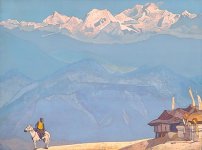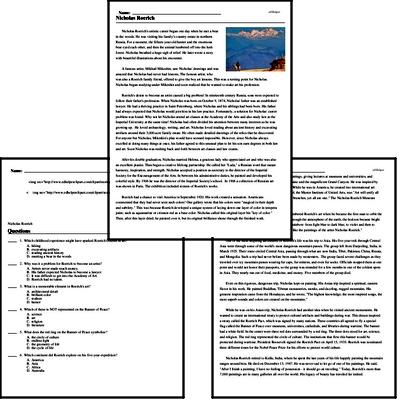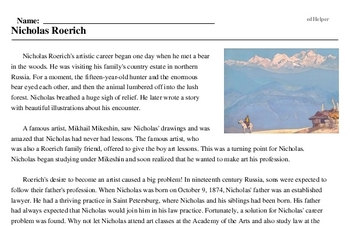Nicholas Roerich
Nicholas Roerich
Reading Comprehension for October 9
Nicholas Roerich's artistic career began one day when he met a bear in the woods. He was visiting his family's country estate in northern Russia. For a moment, the fifteen-year-old hunter and the enormous bear eyed each other, and then the animal lumbered off into the lush forest. Nicholas breathed a huge sigh of relief. He later wrote a story with beautiful illustrations about his encounter.
A famous artist, Mikhail Mikeshin, saw Nicholas' drawings and was amazed that Nicholas had never had lessons. The famous artist, who was also a Roerich family friend, offered to give the boy art lessons. This was a turning point for Nicholas. Nicholas began studying under Mikeshin and soon realized that he wanted to make art his profession.
Roerich's desire to become an artist caused a big problem! In nineteenth century Russia, sons were expected to follow their father's profession. When Nicholas was born on October 9, 1874, Nicholas' father was an established lawyer. He had a thriving practice in Saint Petersburg, where Nicholas and his siblings had been born. His father had always expected that Nicholas would join him in his law practice. Fortunately, a solution for Nicholas' career problem was found. Why not let Nicholas attend art classes at the Academy of the Arts and also study law at the Imperial University at the same time! Nicholas had often divided his attention between many interests as he was growing up. He loved archaeology, writing, and art. Nicholas loved reading about ancient history and excavating artifacts around their 3,000-acre family estate. He often made detailed drawings of the relics that he discovered. For anyone but Nicholas, Mikeshin's plan would have seemed impossible. However, since Nicholas always excelled at doing many things at once, his father agreed to this unusual plan to let his son earn degrees in both law and art. Soon Nicholas was rushing back and forth between art classes and law exams.
After his double graduation, Nicholas married Helena, a gracious lady who appreciated art and who was also an excellent pianist. Thus began a creative lifelong partnership. He called her "Lada," a Russian word that meant harmony, inspiration, and strength. Nicholas accepted a position as secretary to the director of the Imperial Society for the Encouragement of the Arts. In between his administrative duties, he painted and developed his colorful style. By 1906 he was the director of the Imperial Society's school. In 1906 a collection of Russian art was shown in Paris. The exhibition included sixteen of Roerich's works.
Roerich had a chance to visit America in September 1920. His work created a sensation. Americans commented that they had never seen such colors! One gallery wrote that his colors were "magical in their depth and subtlety." This was because Roerich developed a unique system of laying down one layer of color in tempera paint, such as aquamarine or crimson red as a base color. Nicholas called this original layer his "key of color." Then, after this layer dried, he painted over it, but its original brilliance shone through the finished work.



